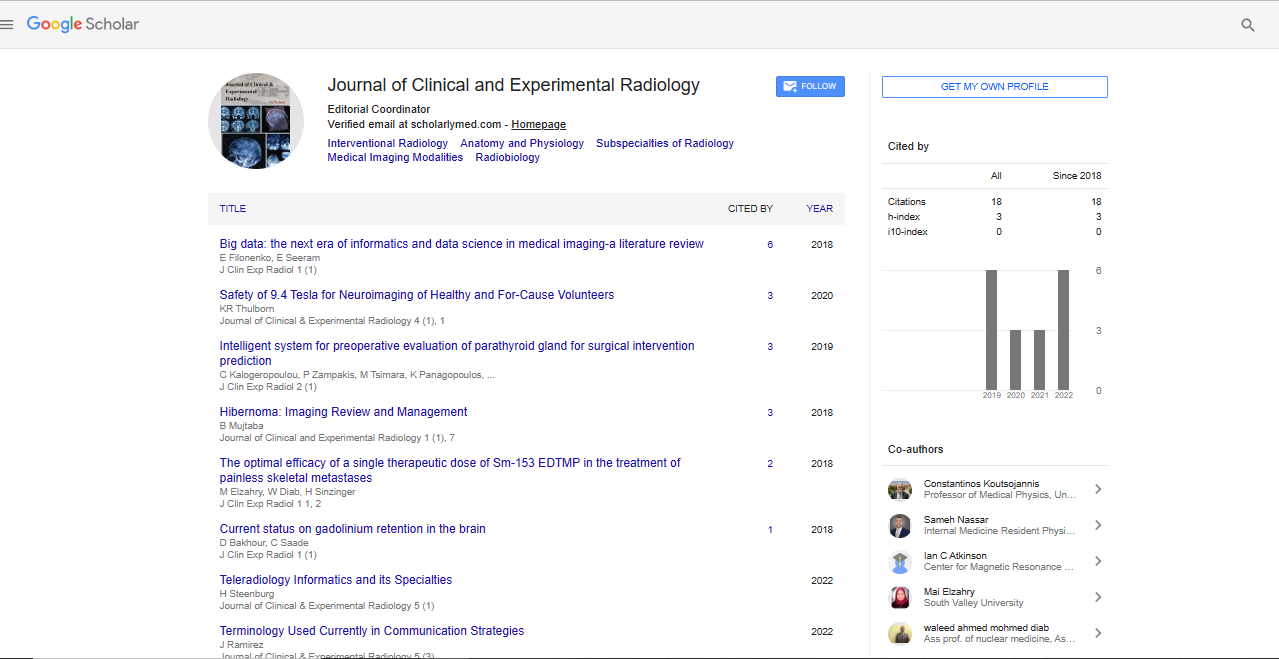Opinion Article, J Clin Exp Radiol Vol: 6 Issue: 2
Medical Precision through the Integration of Genomic and Imaging Phenotypes Data
Lavrova Manon*
1Department of Precision Medicine, Maastricht University, Maastricht, The Netherlands
*Corresponding Author: Lavrova Manon,
Department of Precision Medicine,
Maastricht University, Maastricht, The Netherlands
E-mail: lavro@man.edu
Received date: 28 May, 2023, Manuscript No. JCER-23-106666
Editor assigned date: 31 May, 2023, Pre QC No. JCER-23-106666 (PQ);
Reviewed date: 14 June, 2023, QC No. JCER-23-106666
Revised date: 22 June, 2023, Manuscript No. JCER-23-106666 (R);
Published date: 28 June, 2023, DOI: 07.4172/jcer.1000135
Citation: Manon L (2023) Medical Precision through the Integration of Genomic and Imaging Phenotypes Data. J Clin Exp Radiol 6:2.
Description
In recent years, there has been a growing interest in understanding the underlying genetic basis of various diseases and conditions. Advances in genomic research have provided valuable insights into the role of genetic variations in disease development, progression, and treatment response. Simultaneously, imaging techniques have emerged as powerful tools for non-invasive visualization and characterization of anatomical and functional abnormalities in the human body. The integration of imaging and genomic data holds immense potential for unlocking new insights into disease mechanisms and improving patient care. This study discuss the concept of linking imaging phenotypes to genomic data, highlighting the applications, challenges, and future prospects of this rapidly evolving field.
Imaging phenotypes refer to the measurable characteristics derived from medical images, such as size, shape, texture, and spatial distribution of abnormalities. These phenotypes provide quantitative information about the disease extent, severity, and response to treatment. Imaging phenotypes can be extracted from various imaging modalities, including Computed Tomography (CT), Magnetic Resonance Imaging (MRI), Positron Emission Tomography (PET), and ultrasound. By capturing the anatomical and functional changes associated with diseases, imaging phenotypes offer valuable insights into disease progression and treatment outcomes. Genomic data encompass the information about an individual's genetic makeup, including DNA sequences, gene expressions, and variations (such as single nucleotide polymorphisms). Genomic research has contributed significantly to our understanding of the genetic basis of diseases, including cancer, cardiovascular disorders, neurological conditions, and rare genetic syndromes. By identifying disease-related genetic variations and gene-environment interactions, genomic data provide insights into disease mechanisms, risk prediction, and personalized treatment strategies.
The integration of imaging phenotypes and genomic data offers a unique opportunity to bridge the gap between genotype and phenotype. By correlating imaging features with specific genetic variations or gene expression profiles, researchers can uncover the biological mechanisms underlying imaging phenotypes and their association with disease progression and treatment response. This approach enables the identification of imaging biomarkers that can aid in disease diagnosis, prognosis, and treatment selection. By performing large-scale studies that link imaging phenotypes with genomic data, researchers can identify associations between specific genetic variations and imaging characteristics. For example, studies have shown associations between certain gene mutations and imaging features in cancer, neurodegenerative diseases, and cardiovascular conditions. These findings provide insights into the molecular pathways involved in disease development and progression.
Integrating imaging phenotypes and genomic data allows for the development of predictive models that can estimate disease risk or treatment response. By incorporating genetic information into existing imaging-based risk models, clinicians can better stratify patients and tailor treatment plans accordingly. This approach personalized medicine, where treatment decisions can be guided by an individual's genetic profile and imaging characteristics. Imaging-Genomics associations can also aid in predicting treatment response and monitoring treatment efficacy. By identifying genetic markers associated with treatment resistance or sensitivity, clinicians can select the most appropriate therapy and monitor its effectiveness over time. For example, in oncology, imaging features combined with genomic data can help predict response to chemotherapy or targeted therapies, allowing for early adjustment of treatment strategies. Linking imaging phenotypes to genomic data presents several challenges that need to be addressed for its widespread adoption in clinical practice. These challenges include data harmonization and standardization, privacy and ethical concerns, computational infrastructure, and the need for large-scale collaborative studies. Furthermore, the integration of multiomics data (such as proteomics, metabolomics, and epigenomics) with imaging and genomic data holds the potential to provide a more comprehensive understanding of disease mechanisms and personalized treatment strategies.
The integration of imaging phenotypes and genomic data for advancing our understanding of disease mechanisms, predicting disease risk, and guiding personalized treatment strategies. By identifying associations between imaging features and genetic variations, researchers can unravel the underlying biological pathways and molecular drivers of disease. However, several challenges need to be overcome, including data integration, privacy concerns, and computational infrastructure. With continued advancements in imaging technology, genomic research, and computational methods, the field of linking imaging phenotypes to genomic data is poised to revolutionize disease diagnosis, prognosis, and treatment in the era of precision medicine.
 Spanish
Spanish  Chinese
Chinese  Russian
Russian  German
German  French
French  Japanese
Japanese  Portuguese
Portuguese  Hindi
Hindi 